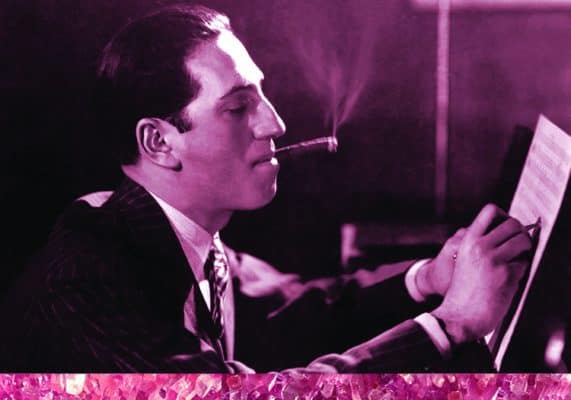
Here’s Gershwin in a nutshell, so you can be ready for the concert tonite!
GEORGE GERSHWIN (1898-1937) – a short story
George Gershwin made his considerable mark on American music in two short decades of composing. Such was the time he was allotted on this earth. His parents were Jewish immigrants who fled the hostilities of tsarist Russia and settled in Brooklyn. He grew up around the Yiddish Theater and Tin Pan Alley, and would become one of the defining voices of the American music theater – yet another demonstration of the quip that Tsar Alexander III did more to found the Broadway musical than Victor Herbert.
Gershwin was a bit of a rough and tumble trouble-maker as a kid. He didn’t even know he cared for music until a piano was brought into the home for his brother. But it was George who would watch the player pianos in store windows, and come home to recreate on his own piano what he had heard and seen. His abilities flourished, and by the time he was 15, he left school and got a job on Tin Pan Alley as a “song-plugger” for $15 a week. Gershwin worked often 10 hours a day playing and singing tune after tune in any key for singers, band leaders, and theater managers to promote sales. Improvising came naturally, and soon he was writing his own songs. His first big hit, “Swanee,” was picked up by Al Jolson. It sold millions in 1919, exactly a hundred years ago, and so at 21 years old, George Gershwin was on his way. Here’s Gershwin playing Gershwin.
The story of George Gershwin’s life can hardly be told without mentioning his brother Ira in the same breath. As his main lyricist, gentle Ira, bookish and retiring, was totally devoted to George. The two wrote nearly twenty Broadway shows and one opera together, and their lives were completely entwined.
As Irving Berlin said “George Gershwin is the only songwriter I know who became a composer,” so it was that George also became a composer of piano and orchestral music – and that music has become embedded into the American musical psyche: Rhapsody in Blue, An American in Paris, Variations on “I got Rhythm,” many overtures, and his masterpiece, Porgy and Bess. These are works that fused the world of jazz with the concert hall in a way that had never been done before, and rarely since. As music historian Rodney Greenberg put it, “Gershwin was living through the ‘crossover’ controversy before the word was invented.”
George’s personality was magnetic. Extroverted and ambitious, one could always find him as the center of attention at parties of the social elite, entertaining onlookers with his luminous, unstoppable energy and dazzling ability at the piano. He could hardly tear himself away from the music and the attention. And he was workaholic, capable of composing at incredible speed, and always desirous of learning so much more, in order to create works that would capture in music the sounds was he constantly hearing in the world around him.
In the end, the story of Gershwin’s life is a short story. His remarkable music, his desire for learning and growing, his big personality, his brilliant mind, his never ending flare for improvisation, all this was all crammed into 38 brief years of living. Gershwin had plans to create many new, explorative chamber and symphonic works, operas and so much more, but he also had an undiagnosed brain tumor. George Gershwin collapsed and died in Hollywood on July 11, 1937. (SD)
See you tonite! – Suzanne
THE GLITTER OF GERSHWIN
with Suzanne DuPlantis, Randall Scarlata, with Harold Evans on the piano
6:30 – Reception
7:00 – Music
at the Academy of Vocal Arts
